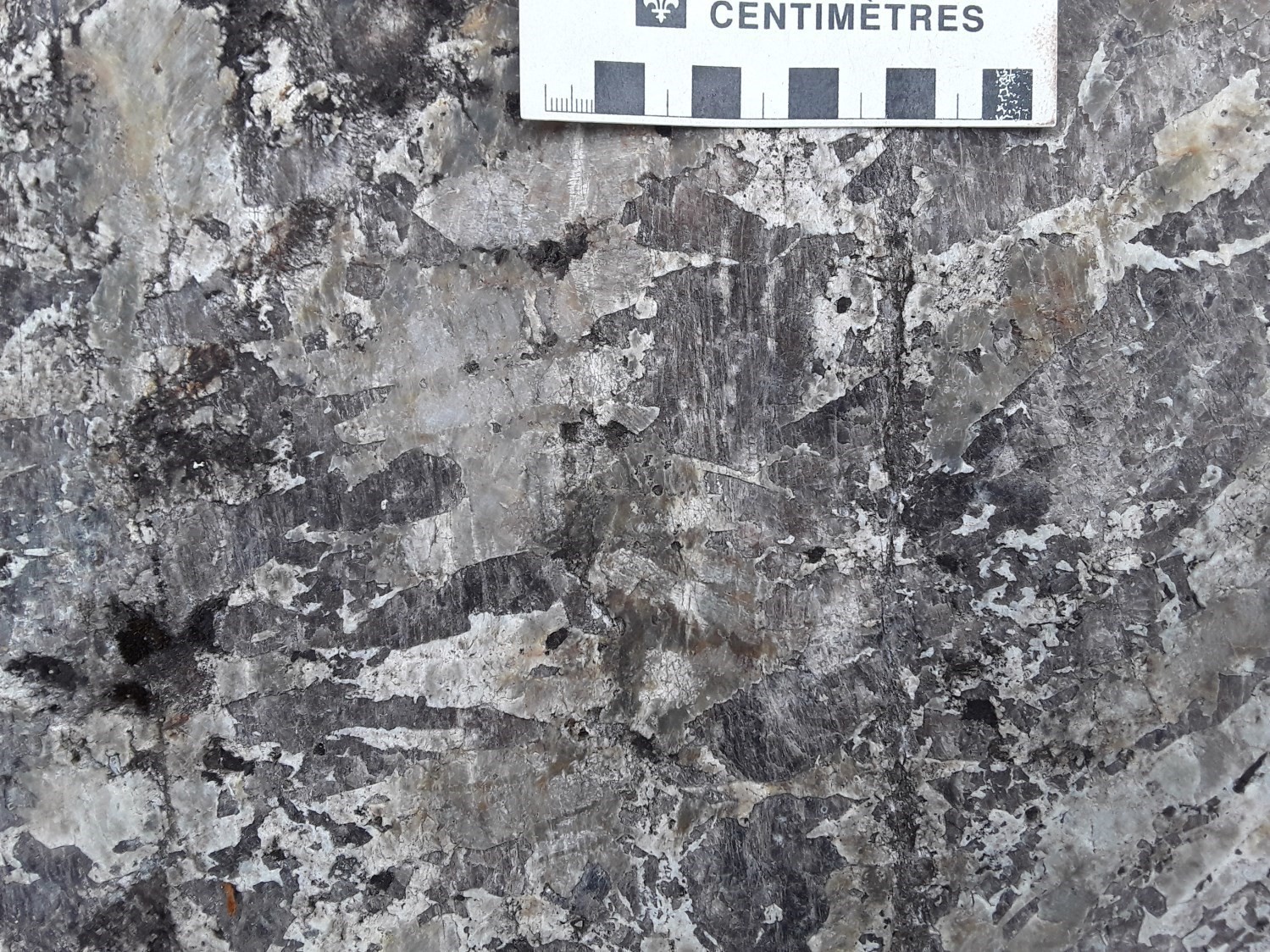
First published: October 4, 2022
Last modified:
DISCLAIMER: This English version is translated from the original French. In case of any discrepancy, the French version shall prevail.
nPiac1 Syenite, feldspathic syenite and quartz syenite
| Author(s): | Bergeron, 1980 |
| Age: | Neoproterozoic |
| Stratotype: | Reference outcrop 2012-PA-03 located 4 km NE of Touladi Lake |
| Type area: | Area south of Lac à la Truite (NTS sheet 32H07) |
| Geological province: | Grenville Province |
| Geological subdivision: | Allochton |
| Lithology: | Alkaline intrusive rocks, carbonatite |
| Category: | Lithodemic |
| Rank: | Lithodeme |
| Status: | Formal |
| Use: | Active |
None
Background
The intrusion was first named the Crevier Alkaline Complex and discovered by SOQUEM in 1975 (in Bergeron, 1980) following an airborne radiometric survey. This discovery was followed by several exploration works by the same company, which led to the discovery of several Nb-Ta mineralizations. Bergeron (1980) completed a master’s degree on the petrography and geochemistry of the various facies forming the complex and its host rock. In 2012, the Ministère initiated a master’s project to study this Nb-Ta mineralization (Groulier et al., 2014). The intrusion was then renamed « Crevier Alkaline Intrusion » to show its late-Grenville intrusive character. Subsequently, Moukhsil and El Bourki (2021) and El Bourki and Moukhsil (2021) studied it during mapping work in the Girardville and Blondelas Lake areas, respectively (sheet 32H07), in the Saguenay–Lac-Saint-Jean region.
Description
The Crevier Alkaline Intrusion consists of a polyphase batholith of alkaline rocks associated with carbonatite. It is cut by several swarms of megacrystic dykes of nepheline syenite composition and Nb-Ta mineralization (contained in pyrochlore). The intrusion is subdivided into several informal units mappable at a 1:50,000 scale: nPiac1a, nPiac1b, nPiac2 and nPiac3. This intrusion hosts several known mineralized zones (e.g., Crevier and Crevier SE).
Crevier Alkaline Intrusion 1 (nPiac1): Syenite, feldspathic syenite and quartz syenite
Crevier Alkaline Intrusion 1a (nPiac1a): coarse-grained, porphyroid, quartz syenite to syenite, locally with nepheline
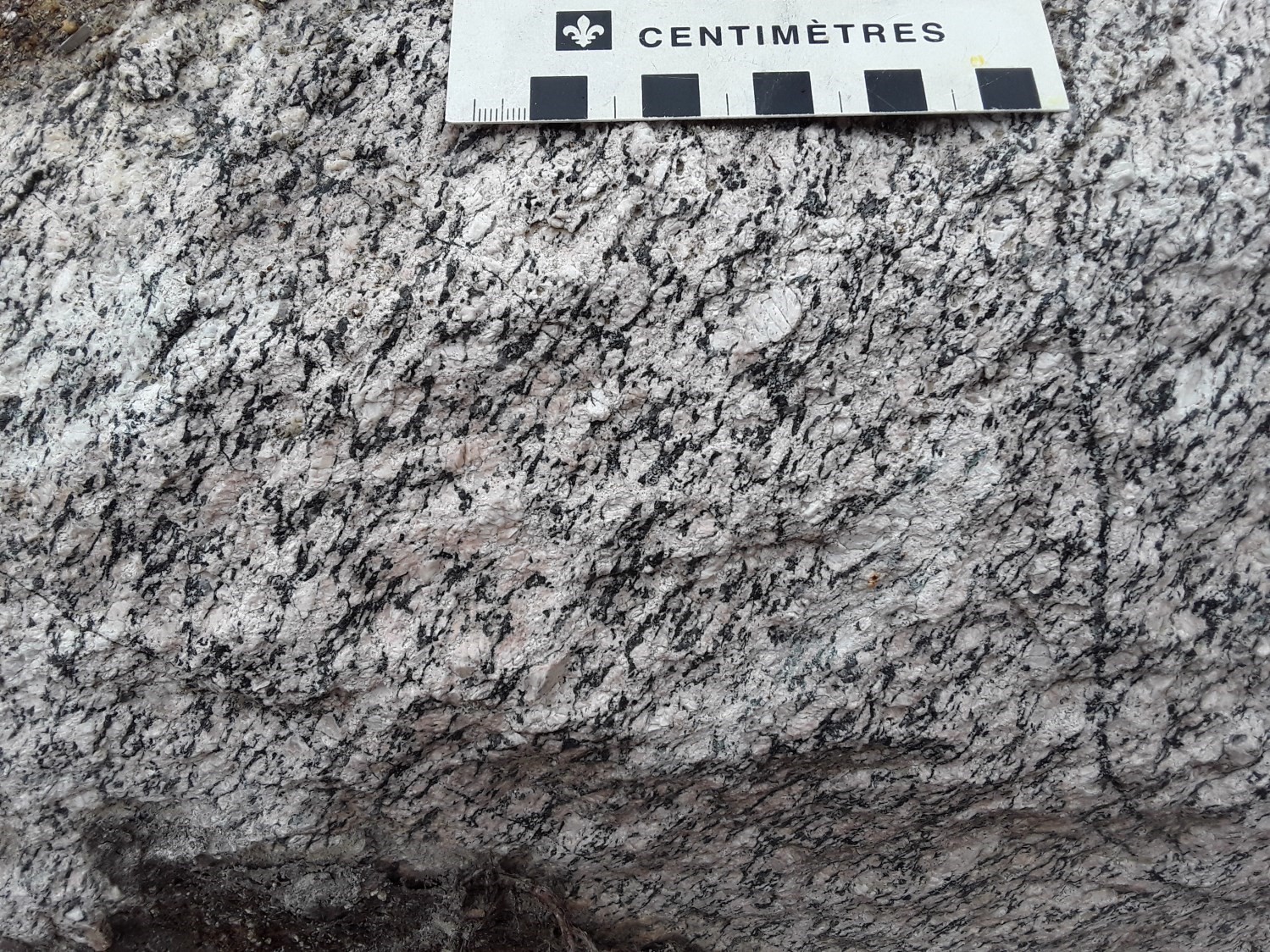
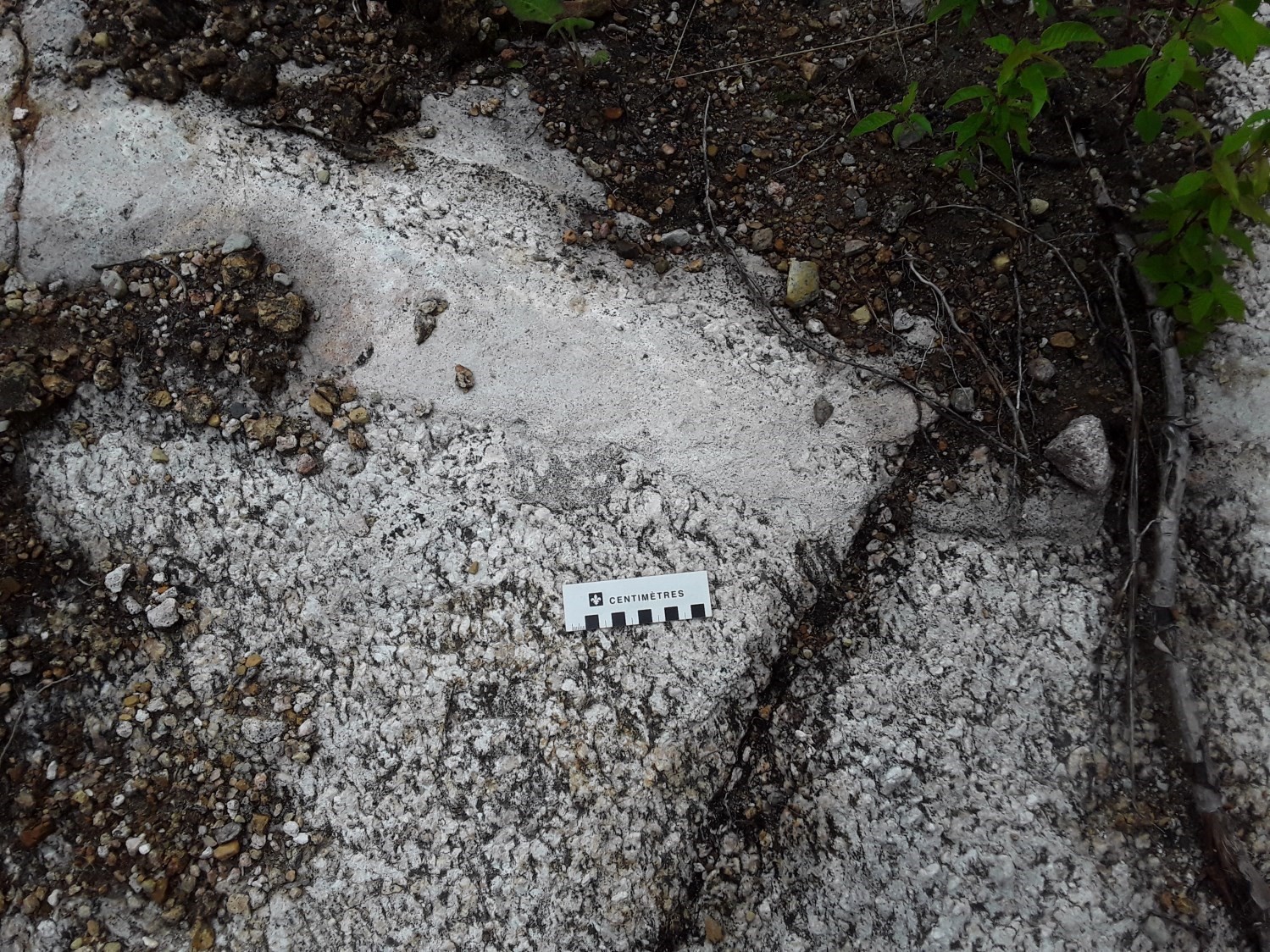 The quartz syenite, locally magnetic, is rust-white in alteration patina and usually pink-grey in fresh surface. It is generally porphyroid, locally coarse grained, with phenocrysts of K-feldspar and plagioclase. Phenocrysts range in size from 1 cm to 5 cm and can make up as much as 50% of the rock. This syenitic facies contains hypersthene (1 to 6%), quartz (<25%) with undulatory extinction, generally perthitic potassium feldspar (50%), plagioclase (<10%), hornblende (<2%), biotite (<4%) locally transformed into chlorite, nepheline (<2% in quartz-free facies) and rarely clinopyroxene. Accessory minerals observed are apatite and zircon. Dykes <20 cm thick, consisting of fine to medium grained syenite and hypersthene syenite, are injected into this quartz syenite. A syenite, white-yellow in alteration patina and light grey in fresh surface, with biotite and traces of nepheline is also part of this unit (outcrop 2021-FS-4163). The facies of this unit form the border of the intrusion. A sodic fenitization is observed locally in veins and veinlets in contact with the host rock. This alteration is manifested by the presence of arfvedsonite and aegirine crystals associated with albite.
The quartz syenite, locally magnetic, is rust-white in alteration patina and usually pink-grey in fresh surface. It is generally porphyroid, locally coarse grained, with phenocrysts of K-feldspar and plagioclase. Phenocrysts range in size from 1 cm to 5 cm and can make up as much as 50% of the rock. This syenitic facies contains hypersthene (1 to 6%), quartz (<25%) with undulatory extinction, generally perthitic potassium feldspar (50%), plagioclase (<10%), hornblende (<2%), biotite (<4%) locally transformed into chlorite, nepheline (<2% in quartz-free facies) and rarely clinopyroxene. Accessory minerals observed are apatite and zircon. Dykes <20 cm thick, consisting of fine to medium grained syenite and hypersthene syenite, are injected into this quartz syenite. A syenite, white-yellow in alteration patina and light grey in fresh surface, with biotite and traces of nepheline is also part of this unit (outcrop 2021-FS-4163). The facies of this unit form the border of the intrusion. A sodic fenitization is observed locally in veins and veinlets in contact with the host rock. This alteration is manifested by the presence of arfvedsonite and aegirine crystals associated with albite.
Crevier Alkaline Intrusion 1b (nPiac1b): coarse-grained nepheline syenite and locally porphyroid feldspathic syenite
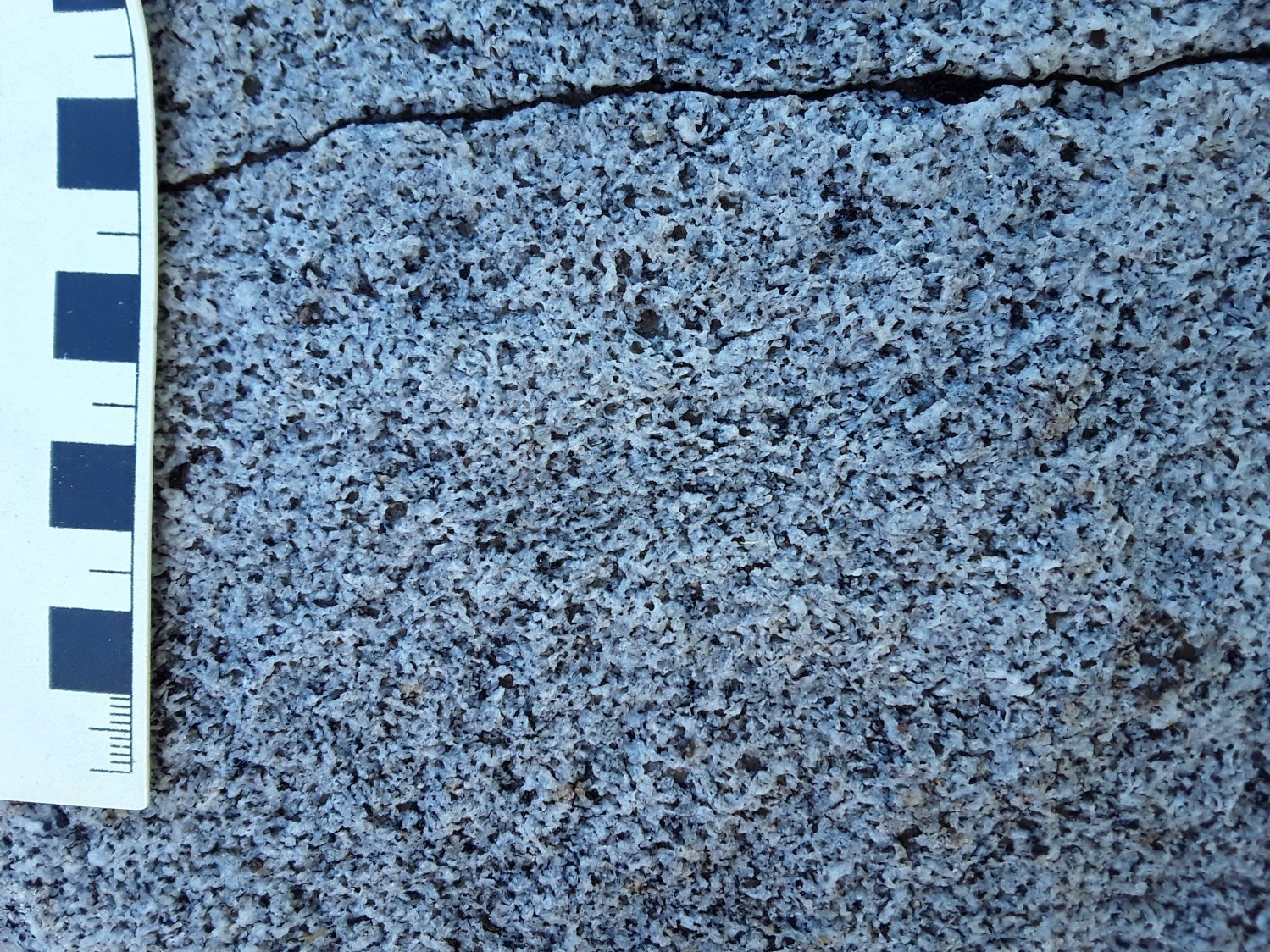

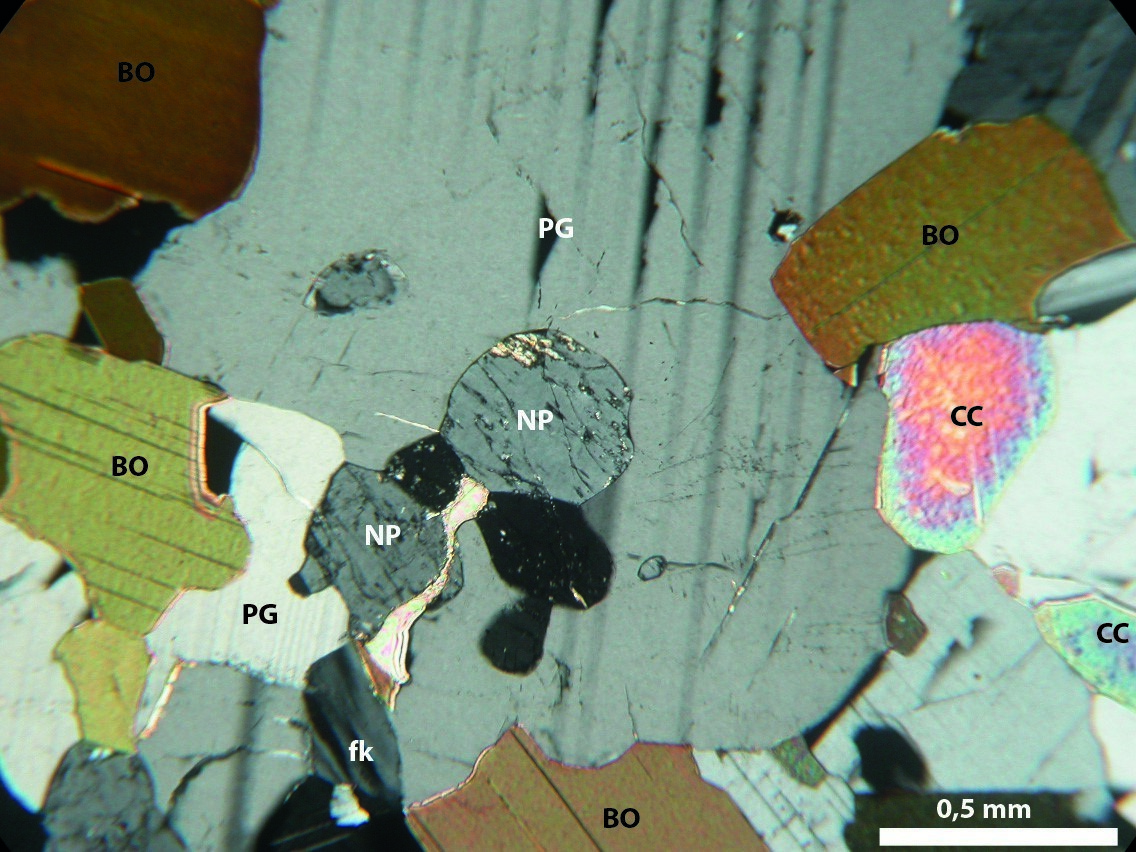 Nepheline syenite is white-grey to pink-white in alteration patina and generally pink-grey in fresh surface. It is holocrystalline, fine to coarse grained and equigranular. It consists of potassium feldspar, orthopyroxene, hornblende, biotite, nepheline, calcite and traces of clinopyroxene associated to opaque minerals. Accessory minerals include magnetite, apatite and zircon. Generally, potassium feldspar is perthitic and automorphic to subautomorphic, nepheline is subautomorphic and its percentage is variable from one outcrop to another (1 to 10%). Calcite (<6%) is interstitial, but may also occur as inclusions in the plagioclase or as veinlets through the other minerals. One sample (outcrop 2021-AM-98) observed under the microscope shows an enrichment of nepheline (12%) associated with large biotite crystals (up to 8%).
Nepheline syenite is white-grey to pink-white in alteration patina and generally pink-grey in fresh surface. It is holocrystalline, fine to coarse grained and equigranular. It consists of potassium feldspar, orthopyroxene, hornblende, biotite, nepheline, calcite and traces of clinopyroxene associated to opaque minerals. Accessory minerals include magnetite, apatite and zircon. Generally, potassium feldspar is perthitic and automorphic to subautomorphic, nepheline is subautomorphic and its percentage is variable from one outcrop to another (1 to 10%). Calcite (<6%) is interstitial, but may also occur as inclusions in the plagioclase or as veinlets through the other minerals. One sample (outcrop 2021-AM-98) observed under the microscope shows an enrichment of nepheline (12%) associated with large biotite crystals (up to 8%).
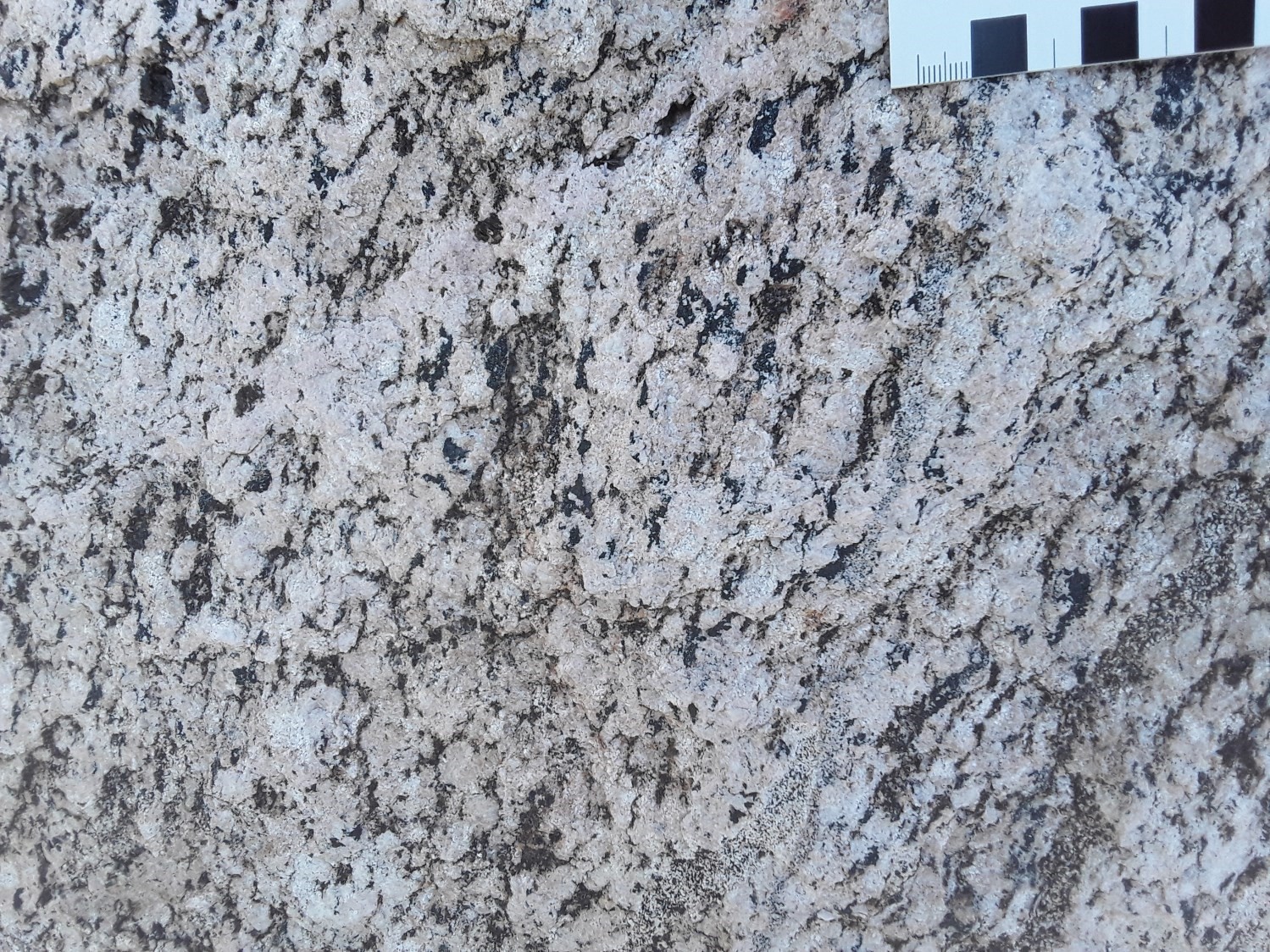
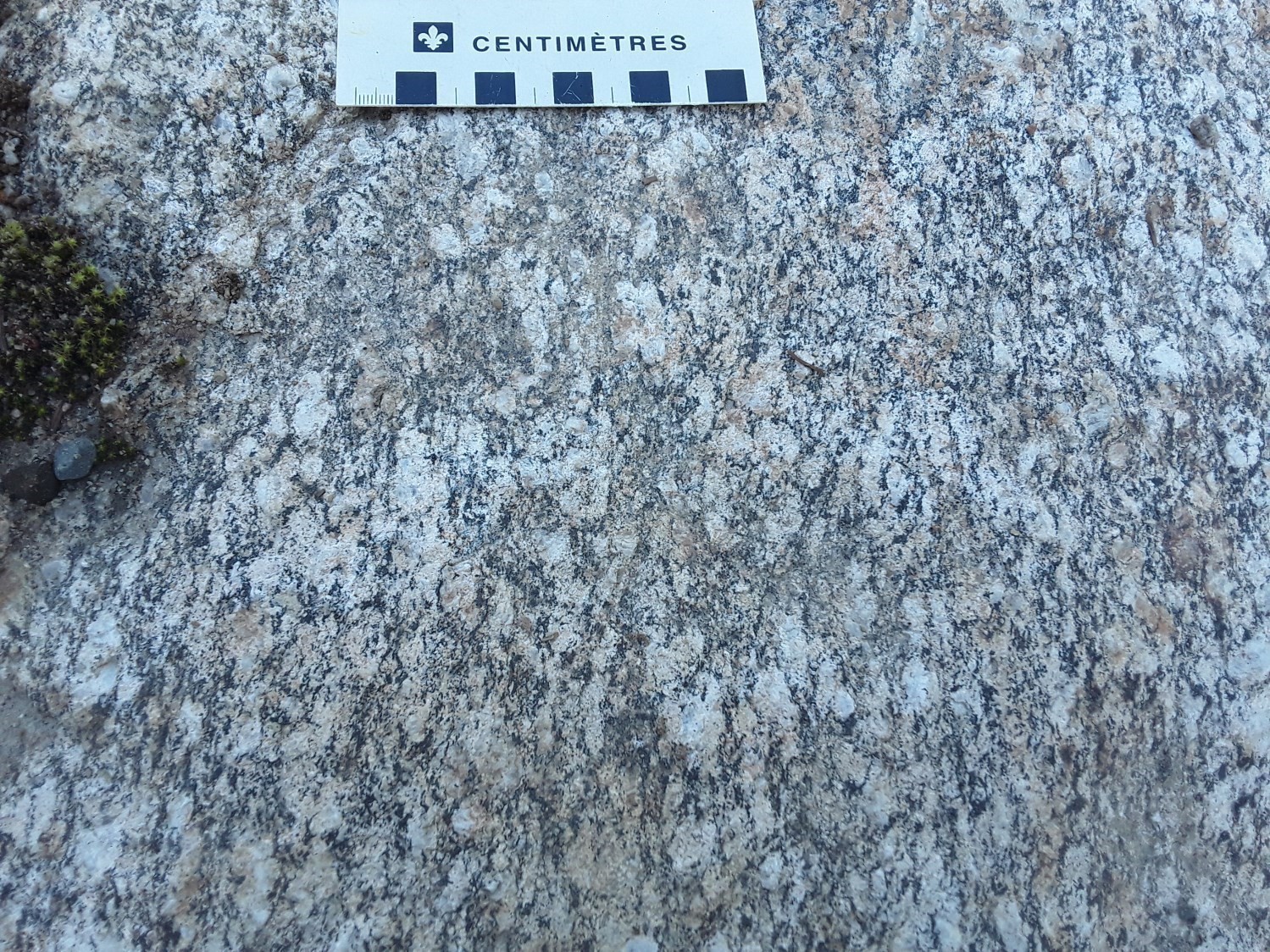 The feldspathic syenite is mapped mainly south and east of Lac à la Truite (northern part of sheet 32H07). It is greyish-white in alteration patina (outcrop 2021-FS-4168) and pink in fresh surface. The rock is medium grained, equant to porphyroid, with phenocrysts of potassium feldspar and plagioclase. It also contains nepheline, biotite and amphibole. In the field, other outcrops (2021-ME-1100, 2021-ME-1099) of this unit also contain calcite and orthopyroxene.
The feldspathic syenite is mapped mainly south and east of Lac à la Truite (northern part of sheet 32H07). It is greyish-white in alteration patina (outcrop 2021-FS-4168) and pink in fresh surface. The rock is medium grained, equant to porphyroid, with phenocrysts of potassium feldspar and plagioclase. It also contains nepheline, biotite and amphibole. In the field, other outcrops (2021-ME-1100, 2021-ME-1099) of this unit also contain calcite and orthopyroxene.
Crevier Alkaline Intrusion 2 (nPiac2): syenite and feldspathic syenite, locally associated with carbonatite; pegmatitic syenitic dykes with pyrochlore and megacrysts of nepheline and albite
Syenite has a greyish alteration patina and a pinkish fresh surface. It is medium to fine grained and its mineralogy varies; with or without quartz, it includes potassium feldspar, plagioclase, biotite and traces of nepheline. At the contact between units nPiac2 and nPiac1b, an outcrop of quartz syenite (2021-FT-3150) is observed. This fine- to medium-grained rock is grey to whitish in fresh and altered surface. Locally, it shows a brecciated structure due to the injection of fine-grained lodes, veins and veinlets of syenitic composition.
 The feldspathic syenite is pink to pinkish-white in fresh surface, medium to coarse grained and contains nepheline, albite, biotite and calcite (outcrop 2021-AM-097). This syenite may also be banded in places. It is greyish in alteration patina and grey-white to pinkish in fresh surface. The bands are characterized by alternating silicate and carbonate levels. Locally, it is difficult to establish the relationship between the two levels because of their granulometric and mineralogical variation and/or the absence of contact between the two. Locally, this contact is either diffuse or clear. The feldspathic syenite contains nepheline, albite, biotite, magnetite and sodalite. In places, this feldspathic syenite is associated with carbonatite and shows a proportion of biotite of up to 15%. The feldspathic syenite is cut by several centimetric dykes of syenite, feldspathic syenite and carbonatite. The feldspathic syenite dykes are grey-black in alteration patina, blackish in fresh surface, medium to pegmatitic in grain size and contain albite, nepheline, biotite and pyrochlore. Syenite dykes are mostly fine grained and consist of potassium feldspar, albite, biotite and calcite.
The feldspathic syenite is pink to pinkish-white in fresh surface, medium to coarse grained and contains nepheline, albite, biotite and calcite (outcrop 2021-AM-097). This syenite may also be banded in places. It is greyish in alteration patina and grey-white to pinkish in fresh surface. The bands are characterized by alternating silicate and carbonate levels. Locally, it is difficult to establish the relationship between the two levels because of their granulometric and mineralogical variation and/or the absence of contact between the two. Locally, this contact is either diffuse or clear. The feldspathic syenite contains nepheline, albite, biotite, magnetite and sodalite. In places, this feldspathic syenite is associated with carbonatite and shows a proportion of biotite of up to 15%. The feldspathic syenite is cut by several centimetric dykes of syenite, feldspathic syenite and carbonatite. The feldspathic syenite dykes are grey-black in alteration patina, blackish in fresh surface, medium to pegmatitic in grain size and contain albite, nepheline, biotite and pyrochlore. Syenite dykes are mostly fine grained and consist of potassium feldspar, albite, biotite and calcite.
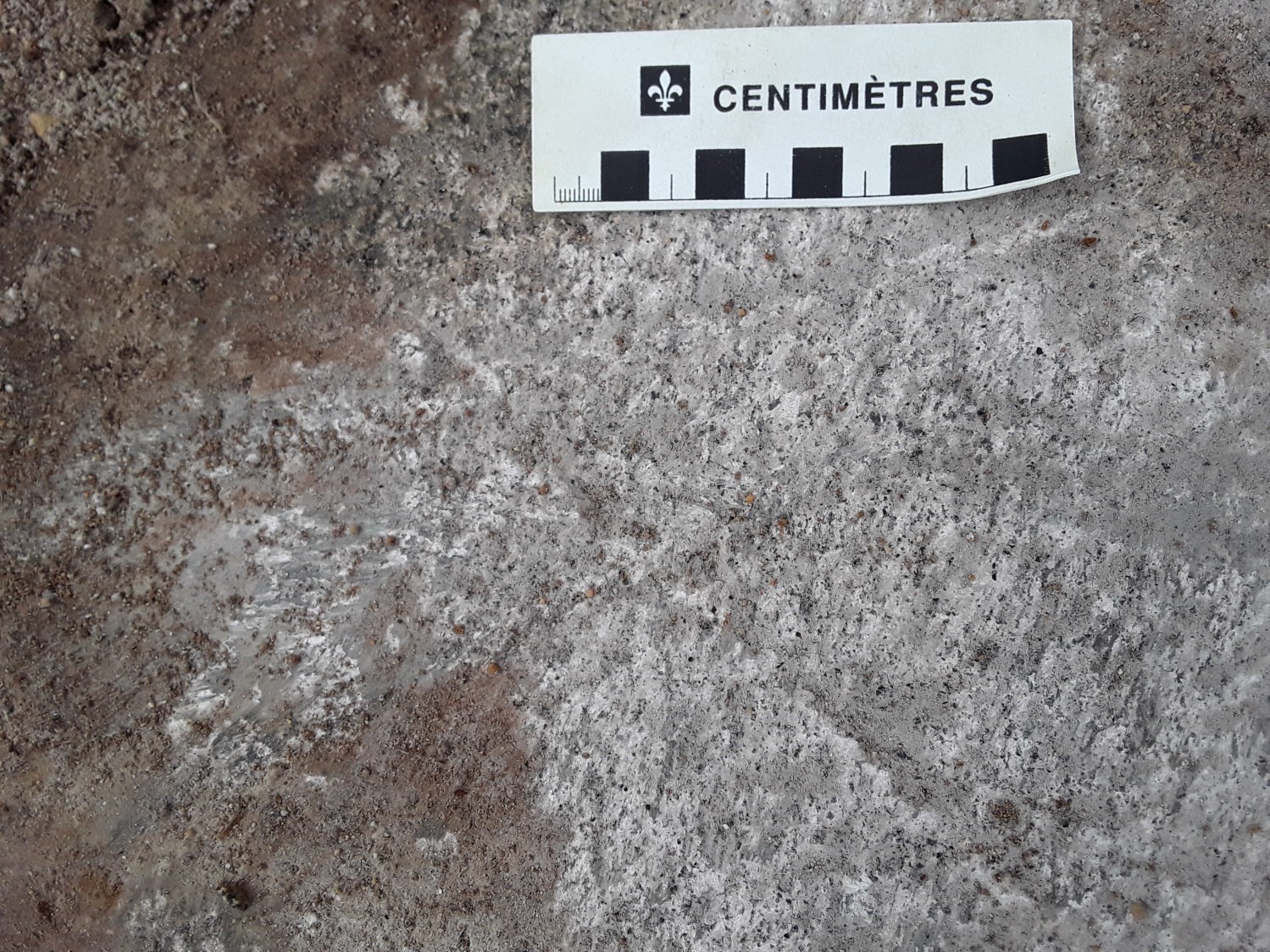

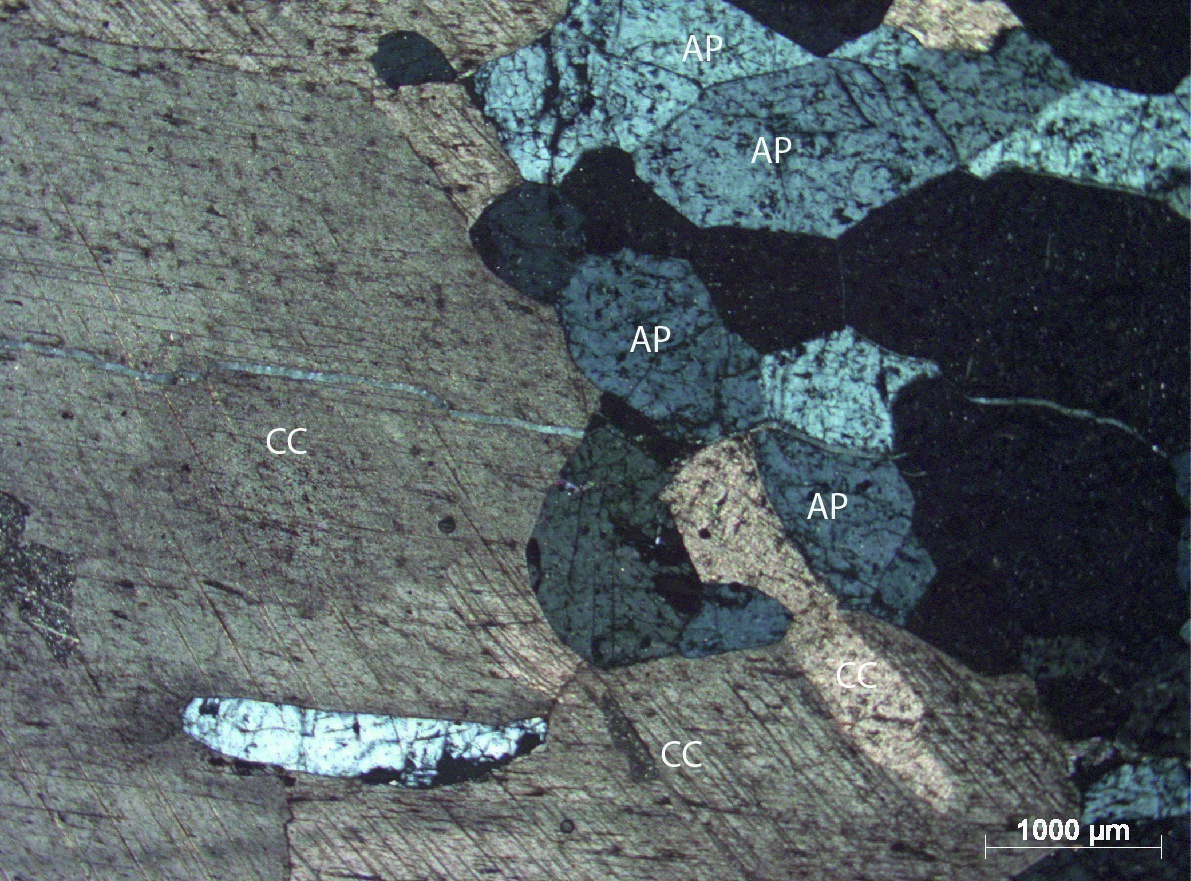 The carbonatites are mainly observed as millimetric to centimetric dykes with a greyish alteration patina and grey-white fresh surface, and a medium to coarse grain size. The carbonatites are calciocarbonatites consisting of >90% calcite. A few outcrops have unaltered biotite and ankerite as well as boxworks of ankerite replaced by a calcite-hematite assemblage (Groulier et al., 2014). The carbonatites also contain biotite, pyrrhotite and automorphic apatite (fluoroapatite), locally as clusters that are mainly located in the coarse-grained phase. The carbonatites are locally enriched in rare earth elements, which are concentrated in the monazite-Ce and rare earth carbonates (Groulier et al., 2014).
The carbonatites are mainly observed as millimetric to centimetric dykes with a greyish alteration patina and grey-white fresh surface, and a medium to coarse grain size. The carbonatites are calciocarbonatites consisting of >90% calcite. A few outcrops have unaltered biotite and ankerite as well as boxworks of ankerite replaced by a calcite-hematite assemblage (Groulier et al., 2014). The carbonatites also contain biotite, pyrrhotite and automorphic apatite (fluoroapatite), locally as clusters that are mainly located in the coarse-grained phase. The carbonatites are locally enriched in rare earth elements, which are concentrated in the monazite-Ce and rare earth carbonates (Groulier et al., 2014).

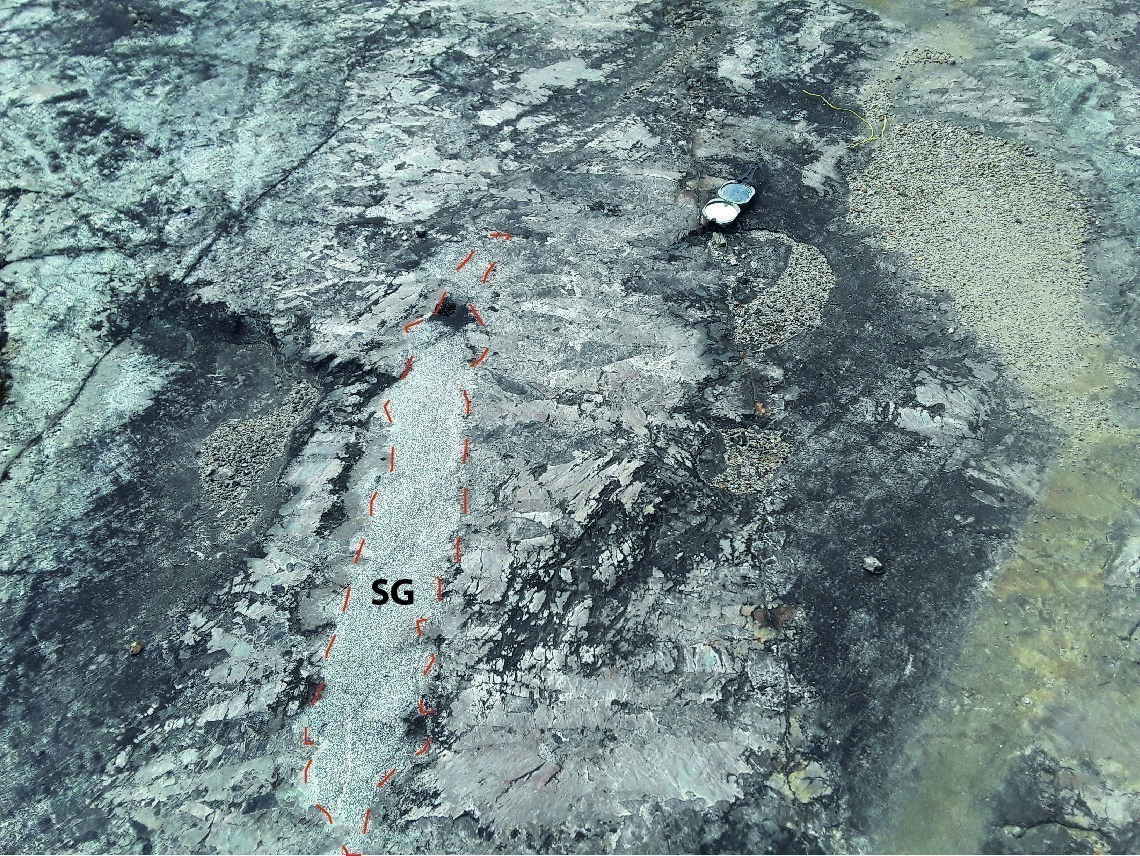 The swarms of dykes are syenitic in composition with nepheline, coarse to pegmatitic in grain size (0.5-35 cm) and have a comb-like structure. They show grey-white weathering and a white-pink fresh surface. Where pegmatitic, the dykes show automorphic to subautomorphic megacrysts of nepheline (25%) and albite (55%). The megacrysts are oriented from the periphery of the dyke towards its centre. The centre of the dyke is generally occupied by a fine-grained grey nepheline syenite. The dykes contain K-feldspar of the orthoclase and microcline types, generally perthitic. Other minerals observed in pegmatitic nepheline syenite are biotite (5%), sodalite (4%), potassium feldspar (<3%), carbonates (3%) and cancrinite (2%) (Groulier et al., 2014). Accessory minerals are magnetite, ilmenite, pyrite, pyrrhotite (some chalcopyrite), pyrochlore and zircon. Locally, sodalite veins cut these pegmatitic dykes. These veins contain sulphides (1%, pyrite and pyrrhotite) and pyrochlore (≥2 mm).
The swarms of dykes are syenitic in composition with nepheline, coarse to pegmatitic in grain size (0.5-35 cm) and have a comb-like structure. They show grey-white weathering and a white-pink fresh surface. Where pegmatitic, the dykes show automorphic to subautomorphic megacrysts of nepheline (25%) and albite (55%). The megacrysts are oriented from the periphery of the dyke towards its centre. The centre of the dyke is generally occupied by a fine-grained grey nepheline syenite. The dykes contain K-feldspar of the orthoclase and microcline types, generally perthitic. Other minerals observed in pegmatitic nepheline syenite are biotite (5%), sodalite (4%), potassium feldspar (<3%), carbonates (3%) and cancrinite (2%) (Groulier et al., 2014). Accessory minerals are magnetite, ilmenite, pyrite, pyrrhotite (some chalcopyrite), pyrochlore and zircon. Locally, sodalite veins cut these pegmatitic dykes. These veins contain sulphides (1%, pyrite and pyrrhotite) and pyrochlore (≥2 mm).
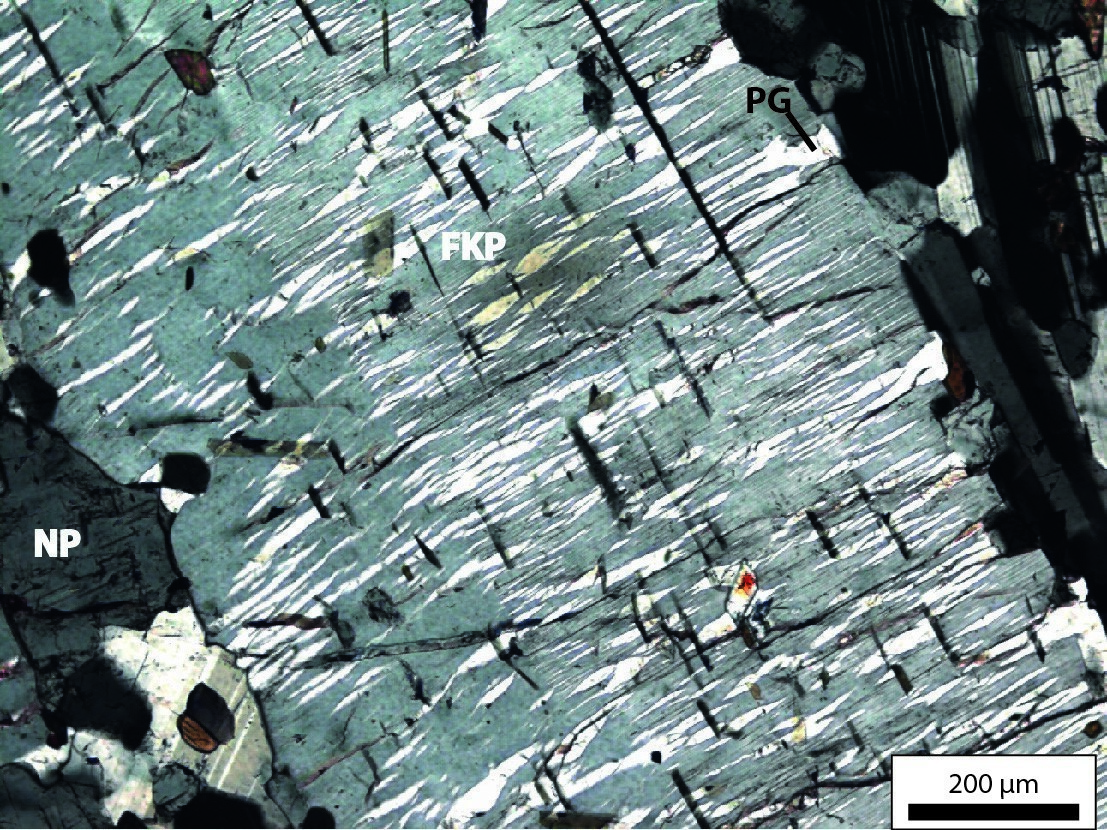
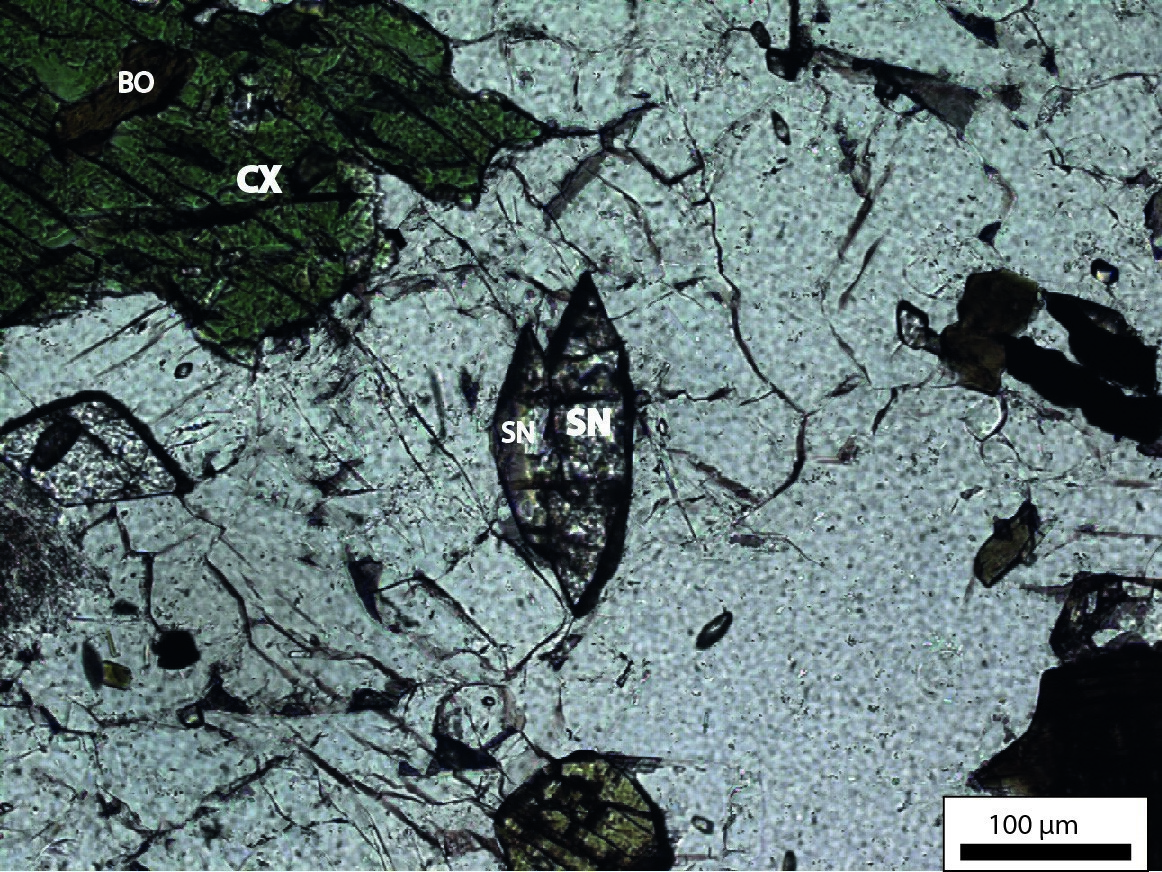 An ijolite phase was described in the work of Groulier et al. (2014). The sample studied was taken from a drill core. The ijolite is mesocratic, homogeneous, holocrystalline and porphyroid. The rock contains phenocrysts of perthitic and non-perthitic K-feldspar, some of which exhibit Carlsbad twims. Other minerals are nepheline, plagioclase, titanite, biotite, clinopyroxene (aegirine), magnetite and traces of calcite.
An ijolite phase was described in the work of Groulier et al. (2014). The sample studied was taken from a drill core. The ijolite is mesocratic, homogeneous, holocrystalline and porphyroid. The rock contains phenocrysts of perthitic and non-perthitic K-feldspar, some of which exhibit Carlsbad twims. Other minerals are nepheline, plagioclase, titanite, biotite, clinopyroxene (aegirine), magnetite and traces of calcite.
Crevier Alkaline Intrusion 3 (nPiac3): alkali feldspar syenite
This unit is recognized SW of the Crevier Alkaline Intrusion and has been defined by two drill holes (Fournier, 2003). The perimeter of this unit was established by geophysics and by the earlier work of SOQUEM (1976 to 1978) cited by Bergeron (1980). The work by El Bourki and Moukhsil (2021) did not allow for visits to the outcrops belonging to this unit. This unit is devoid of nepheline (Fournier, 2003) and consists of a fine- to medium-grained alkali-feldspar syenite. The rock shows a greyish weathering and a pink-grey fresh surface. It is composed of K-feldspar, albite, and calcite. Moreover, it is enriched in biotite. Calcite is interstitial between feldspar grains (Bergeron, 1980).
Thickness and distribution
The Crevier Alkaline Intrusion is pear-shaped and elongated along a 320° axis. The southern part is more or less subcircular and the northern part is more elongated. It outcrops mainly in sheet 32H07 and continues northwards (sheet 32H10).
Dating
Isotopic dating of a coarse-grained nepheline-syenite sample (outcrop 2012-PA-011) gave a Late Grenvillian age for the emplacement of the Crevier Alkaline Intrusion.
| Unit | Sample Number | Isotopic System | Mineral | Crystallization Age (Ma) | (+) | (-) | Reference(s) |
| nPiac1b | 2012-PA-011B1 | U-Pb | Zircon | 957.5 | 2.9 | 2.9 | Groulier et al., 2014 and 2020 |
Stratigraphic Relationship(s)
The Crevier Alkaline Intrusion is injected into the Vertu Plutonic Suite (mPvet2), which constitutes its host rock. The border of the intrusion (nPiac1a) is highly deformed at the contact with the host. The intrusion contains some rare paragneiss enclaves from the Barrois Complex (mPboi4).
Paleontology
Does not apply.
References
Publications available through SIGÉOM Examine
EL BOURKI, M., MOUKHSIL, A., 2021. Géologie de la région de Dolbeau-Blondelas, Province de Grenville, région du Saguenay-Lac-Saint-Jean, Québec, Canada. MERN; BG 2022-02, 1 plan.
GROULIER, P. A., OHNENSTETTER, D., ANDRE-MAYER, A. S., ZEH, A., SOLGADI, F., MOUKHSIL, A., EL BASBAS, A., 2014. ÉTUDE DES MINÉRALISATIONS EN NB-TA DE L’INTRUSION ALCALINE DE CREVIER. UMR 7359 GEORESSOURCES, AQAT – URSTM, GOETHE UNIVERSITAT, MERN; MB 2014-33, 68 pages, 11 plans.
FOURNIER, A., 2003. Rapport de la campagne de forage, automne 2002, projet Crevier no 116. CAMBIOR INC, assessment work submitted to the Government of Québec; GM 60572, 487 pages, 22 plans.
MOUKHSIL, A., EL BOURKI, M., 2021. Géologie de la région de Girardville, Province de Grenville, région du Saguenay–Lac-Saint-Jean, Québec, Canada. MERN; BG 2021-02, 2 plans.
Other publications
BERGERON, A., 1980. Pétrographie et géochimie du complexe igné alcalin de Crevier et de son encaissant métasomatisé. Université du Québec à Chicoutimi; master’s thesis, 142 pages. constellation.uqac.ca/1824/1/1300469.pdf
GROULIER, P.-A., TURLIN, F., ANDRÉ-MAYER, A.-S., OHNENSTETTER, D., CRÉPON, A., BOULVAIS, P., POUJOL, M., ROLLION-BARD, C., ZEH, A., MOUKHSIL, A., SOLGADI, F., EL BASBAS, A., 2020. Silicate-Carbonate Liquid Immiscibility: Insights from the Crevier Alkaline Intrusion (Quebec). Journal of Petrology, volume 61, Issue 3, pages 1-39. doi.org/10.1093/petrology/egaa033
Suggested Citation
Ministère de l’Énergie et des Ressources naturelles (MERN). Crevier Alkaline Intrusion. Quebec Stratigraphic Lexicon. https://gq.mines.gouv.qc.ca/lexique-stratigraphique/province-de-grenville/intrusion-alcaline-de-crevier_en [accessed on Day Month Year].
Contributors
|
First publication |
Abdelali Moukhsil, P. Geo., Ph.D. abdelali.moukhsil@mern.gouv.qc.ca; Mhamed El Bourki, GIT, M.Sc. mhamed.elbourki@mern.gouv.qc.ca (redaction) Mehdi A. Guemache, P. Geo., Ph.D. (coordination); Fabien Solgadi, P. Geo., Ph.D. (critical review); Simon Auclair, P. Geo., M.Sc. (editing); Catherine Tremblay (English version); Ricardo Escobar Moran (HTML editing). |

